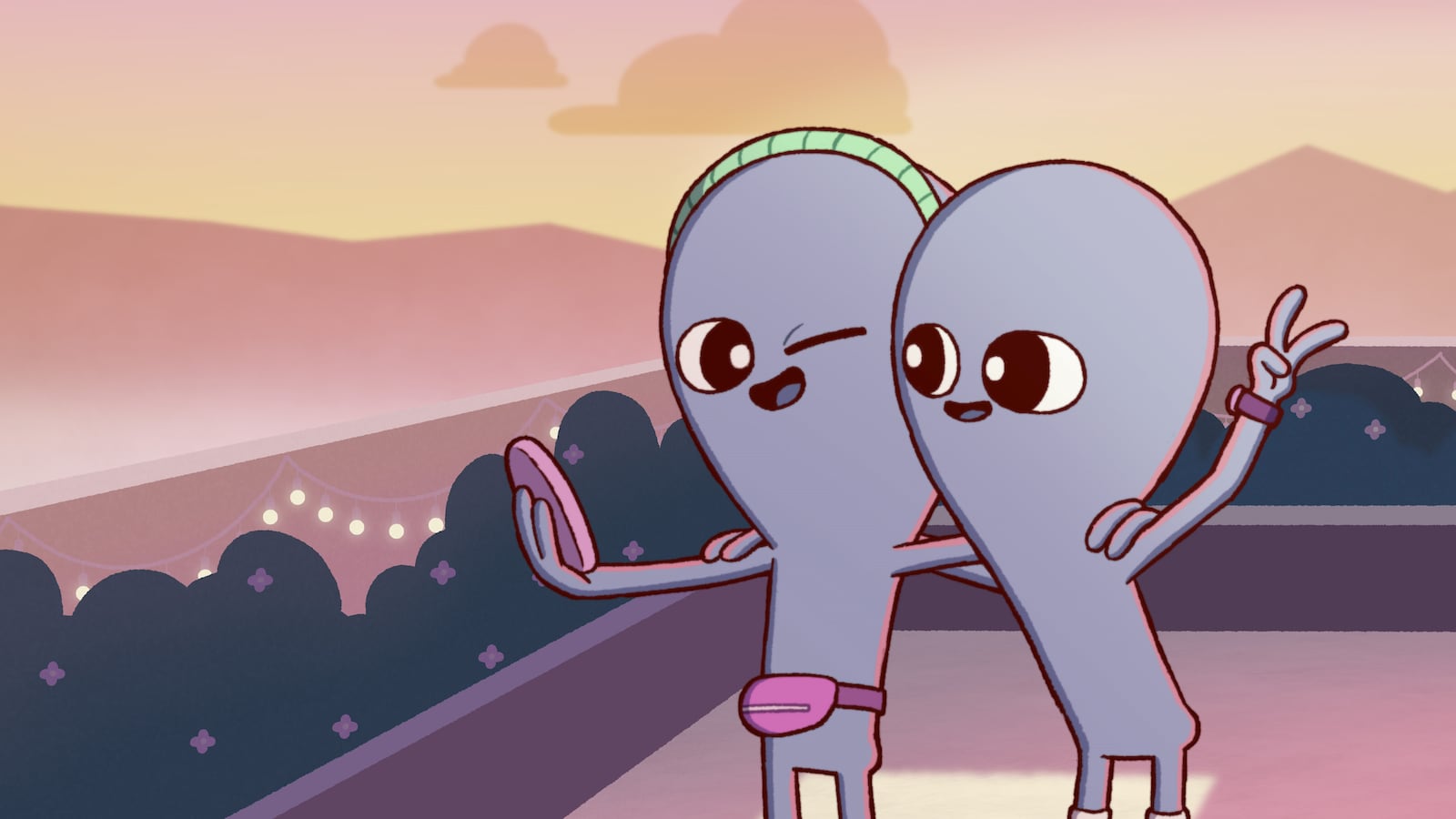In only four years, writer and cartoonist Nathan W. Pyle’s Strange Planet webcomics have become a beloved staple of internet meme virality. Since 2019, Pyle’s drawings of little blue aliens—who experience the same uniquely human phenomena that we do, but express their feelings about them in a hyper-literal manner—have garnered 6.6 million Instagram followers and resulted in two bestselling compilation books. Like most things able to achieve this level of instant, inescapable popularity among both Facebook moms and Reddit addicts, Strange Planet is now its own television series, premiering on Apple TV+ Aug. 8.
While hardly prone to the insufferable banalities of other meme-to-screen creations like Is It Cake? and Haters Back Off, the Strange Planet series still struggles to expand its bite-sized observations about humanity into full episodes. The show often feels like more work to watch than it’s ultimately worth, incessantly asking viewers to unwrap its technical language for everyday occurrences. That’s not too unreasonable of a demand, but it keeps a thin layer between the art and its audience, one that not even Strange Planet’s beautifully rendered animation and some pleasant voice acting can perforate.
The little anthropomorphic creatures in Strange Planet move, speak, and operate just as we humans do, with one major exception: Things in their world may look like objects we have on Earth, but the names for those things are almost overly exact to their nature. For example, peaches become “fuzzy juice orbs,” onion rings are “crying circles,” and coffee and alcohol are labeled “jitter juice” and “mild poison,” respectively. The little blue beings in the series experience revolutions, not birthdays. They do not have parents, they have life-givers. Basically, if you look at any item and can think of an overcomplicated yet completely precise way to describe it, you’ll understand the basis of Strange Planet’s humor.
Like Pyle’s comics, the series seeks to highlight the innate absurdity of being alive. It’s a clever way to introduce people of all ages to the sometimes crushing, inescapable hilarity of existentialism—if your kids are into that sort of thing. While the series is as pragmatic as it is silly, it does try to conjure some poignancy from its analytical approach to storytelling. Whether or not those attempts land successfully amid all of Strange Planet’s elaborate ideas about earthly mortality is another matter altogether.

Each episode of the series is less than half an hour long, all with a varying level of ability to accomplish the task at hand: making the mundane realities of life funny. While the show isn’t exactly linear, it does have characters who develop over the course of the 10-episode first season. Some might find the fact that the beings are all nameless a hindrance when it comes to following their story arcs, but defining characteristics (glasses! scarves! purple eyeshadow!) make for helpful identifiers. Episodes that focus more on developing these characters and less on putting the Strange Planet spin on some temporal activities—such as air travel or professional sports—succeed without having to try so hard to mix comedy with pathos.
But even with some major peaks and valleys, Strange Planet is always a joy to look at. Pyle’s distinct style—with its soft, round edges and stunning blues, pinks, purples, and greens—translate gorgeously from page to screen. Though Pyle is a co-creator of the show, the product is sleeker and more polished than some of his comics, with a lovely mixture of 2D and 3D animation styles that give the show a depth that its writing often fails to deliver. On the basis of visuals alone, Strange Planet is quite dazzling. It doesn’t try too hard to reach new heights of animation when its smooth, cool color palette and appealing creature design feel unique enough in a world of Big Mouth and Family Guy.
A wonderful cast of recurring voice actors—including Community’s Danny Pudi and Hacks’ Hannah Einbinder, among many other familiar recurring names—deftly give their respective beings plenty of characteristic nuance. But the show’s scripts undercut those performances with their insistence on overdoing Strange Planet’s conceit. I found myself wondering why one episode’s major plot points involved “flip-floppers,” aka pancakes, when “pancake” is already an extremely literal name for this breakfast treat. There often seems to be an obsession with finding amusing ways to describe everyday objects, and that gimmick quickly becomes tiring when an episode doesn’t have any emotional resonance.

What’s more, the entire concept of Strange Planet feels wildly outdated. It’s somewhat shocking that Pyle began these comics in 2019, when their niche comedy is distinctly 2011, back when these kinds of absurdist, observational jokes were done better on Portlandia. The series’ humor would be comfortably situated alongside bacon paraphernalia and mustache finger tattoos, dug out of the bargain bin in the home and gifts department of an Urban Outfitters that’s about to be demolished. Funnily enough, in that way, Strange Planet can sometimes even be pleasantly nostalgic—but those flashes are as fleeting as the show’s non-platitudinal sentimentality.
But maybe the series is just suffering from growing pains. The leap from a successful four-panel webcomic to an entire television show is a pretty big one, as much as that pipeline is all too common in our hyper-digital age. There’s real heart in Strange Planet, buried somewhere beneath all of its artifice—and some sturdy humor too. (I’m still amused by a joke about avocados having a 20-minute window between being rocks and turning to pure mush.) Yet Strange Planet’s lack of cohesion might just be a telltale sign that not everything that works in miniature doses can thrive when expanded. That should be okay, too. It’s fine for some things to stay exactly as they are, it gives us new goals to strive for. Ironically, that might be the one observation about humanity that Strange Planet could never quite wrap its head around.
Liked this review? Sign up to get our weekly See Skip newsletter every Tuesday and find out what new shows and movies are worth watching, and which aren’t.






